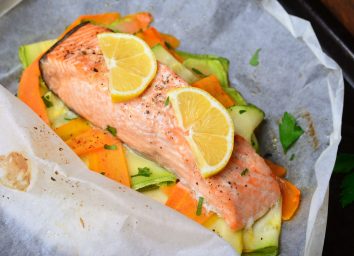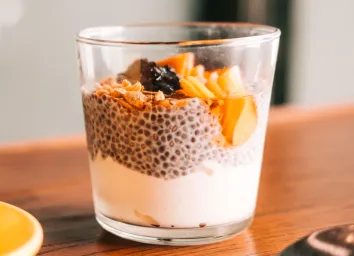Anti-Inflammatory Diet 101: Your Guide To Lowering Chronic Inflammation

Your body is equipped with its own internal protection mechanism: the immune system. It fights off colds, bug bites, and major illness, and strives to keep your body functioning properly. One of the side effects of your immune system kicking in is an increase in inflammation. While this is a completely natural process, the problem lies when your body is in a constant state of inflammation, known as "chronic inflammation." And when your body is battling inflammation of any kind, an anti-inflammatory diet can help relieve your symptoms and even lower the inflammation itself.
We spoke to two dietitians to put together this anti-inflammatory diet explainer: a guide to how this diet can help you lower the chronic inflammation that is the root of weight gain, skin problems, and digestive issues.
What is inflammation?
Inflammation can come from a variety of sources and is usually the result of a response from your body's immune system.
"The role our immune system plays in our health is to protect the body from foreign invaders called antigens. These invaders can take shape as the pollen that triggers your allergies, the bacteria in the nail you step on that causes swelling and soreness, or the food you may be sensitive to that causes hives and itching," says Kristin Kirkpatrick, MS, RDN, registered dietitian nutritionist and lead dietitian at Wellness Nutrition Services at Cleveland Clinic Wellness & Preventive Medicine.
When your immune system responds to antigens, it attacks the antigens to get your body back to normal.
"The immune system does this by releasing cytokines, which induce inflammation and respond to infections. Swelling, for example, is your body's mechanism to isolate an injury and spare other cells around it," says Kirkpatrick. "So essentially, during the process of inflammation, your body develops defense mechanisms. The injury is repaired and the inflammation is eventually resolved."
What happens when your body is in a chronic state of inflammation?
"When we are fighting inflammation on a chronic basis, inflammation becomes the enemy," says Angel Planells, MS, RDN, a Seattle-based registered dietitian nutritionist and spokesperson for the Academy of Nutrition & Dietetics.
Inflammation can present itself in different ways throughout your body, from fatigue to fatigue to abdominal pain. Most notably, many chronic diseases are linked to chronic inflammation:
- Alzheimer's disease
- arthritis
- cancer
- type II diabetes
- hypertension and cardiovascular disease
- obesity/overweight
"We can help manage some of this inflammation by focusing on the contents of our pantry," says Planells. And that's where the anti-inflammatory diet comes in.
What is the anti-inflammatory diet?
Diet can play a huge role in reducing inflammation throughout the body. An anti-inflammatory diet is high in foods that decrease levels of inflammation, but perhaps more importantly, it does avoids foods that are common culprits of increasing inflammation. There are multiple studies that have shown a reduction of inflammatory factors with certain dietary approaches. For example, a 2018 study showed evidence that anti-inflammatory diets could help prevent early death, while a recent 2019 study showed than an anti-inflammatory diet could help in the prevention of certain cancers.
What foods should you eat on an anti-inflammatory diet?
"We are looking for foods with certain protective factors," says Planells. According to a 2015 study, many of the foods that reduce inflammation are rich in antioxidant polyphenols. As such, an anti-inflammatory diet is high in colorful foods. The color represents "high phytonutrient/antioxidant levels," Kirkpatrick says. These anti-inflammatory foods include:
- tomatoes
- olive oil
- green leafy vegetables
- various nuts and seeds (almonds, pistachios)
- fatty fish (tuna, salmon, mackerel)
- variety of fruits and veggies in a number of colors
"These foods contain antioxidants that are beneficial and protective to the body," says Planells. "The lycopene in cooked tomatoes is beneficial for prostate health. The dark, green leafy vegetables contain beta-carotene, lutein, and zeaxanthin, which are beneficial for age-related macular degeneration. We are able to absorb more of these anti-inflammatory nutrients if some fat is added, so drizzle some olive oil on top of your greens."
Inflammatory foods to skip.
"On the most basic level, any food that provides minimal to no nutrient density should be avoided [on an anti-inflammatory diet]," says Kirkpatrick.
Foods you should limit on an anti-inflammatory diet are inflammatory foods, such as:
- refined carbohydrates
- soda (and other sugar-sweetened beverages)
- fried foods (fries and other fried foods)
- red and processed meats
"Decrease the number of these foods, and increase the number of the beneficial foods if possible," says Planells.
A one-day anti-inflammatory diet meal plan.
Here are two examples of a one-day, anti-inflammatory meal plan you can follow.
Meal Plan #1
- Breakfast: steel-cut oats with blueberries and slivered almonds
- A.M. Snack: apple with peanut butter (that does not contain added sugar)
- Lunch: salad greens with carrots, tomatoes, and radishes with a side of wild grilled salmon
- P.M. Snack: sweet potato with pecans
- Dinner: lentil soup with kale and whole grain bread
- Dessert: beet chips or mixed fruit with goji berries
Meal Plan #2
- Breakfast: Greek Yogurt with some walnuts sprinkled in and blueberries
- A.M. snack: baby carrots with hummus
- Lunch: Kale Caesar salad with Salmon
- P.M. Snack: chips with salsa
- Dinner: Kalbi (Korean flavored steak), quinoa & kimchi
- Evening Snack: peanut butter with apple slices
Who should try an anti-inflammatory diet?
Good news: the anti-inflammatory diet is safe for anyone.
"If we are eating a nutrient-dense, whole food diet, and combining that with stress management, adequate sleep, and good relationships—then we are following an anti-inflammatory way of life," says Kirkpatrick.
Adds Plannells, "I think there is always room for improvement for most of us. When we look at the Dietary Guidelines for Americans, the typical American consumes 1 serving of fruits and vegetables per day. The goal would be to improve our overall diet, and this includes making intentional shifts in the way we eat and shop so we are set up for success." Because the anti-inflammatory diet focuses on eating more whole foods and avoiding processed foods that cause inflammation, this diet is a good way for anyone to improve their health.
How to start an anti-inflammatory diet.
Trying an anti-inflammatory diet may seem intimidating, but it's all about making small changes.
"I do know that throughout my years of working with clients, a common thought is that the recommendations (i.e. 5-7 servings of fruits and vegetables per day) feel so far out of reach for some that people throw in the towel," says Planells. "Behavior change doesn't happen overnight. If you are only consuming 1 serving of fruit a day, make it a goal to try to get 2 or 3 in, and gradually shift from there."
While an anti-inflammatory diet may require more food prep, there are tons of resources to help you plan.
"Go and watch some YouTube videos or check out a number of sites to help with some ideas, and don't be afraid to incorporate some quick and easy fixes to help get your nutrients in, including canned (i.e tomato sauce) and frozen products (i.e. berries and various veggies) to help with time and cost. These products are not inferior as they are picked at ripe freshness and can help you quickly throw a meal together."








